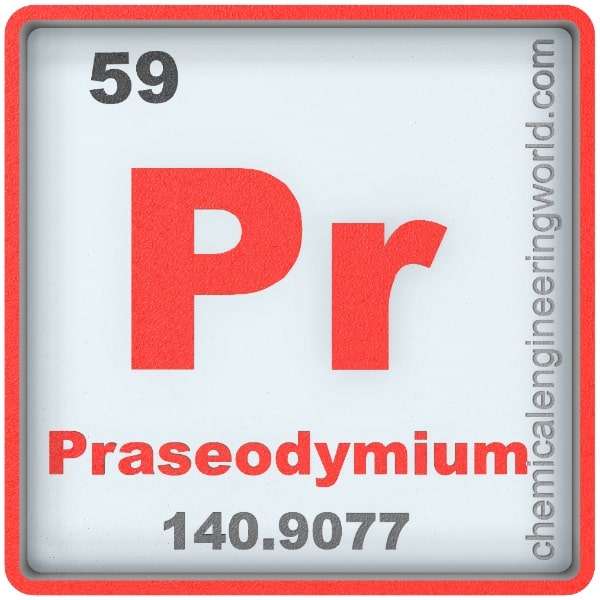Praseodymium Element Properties and Information

Praseodymium Element Properties and Information
Praseodymium is 59th element on the periodic table. Elements are arranged in the periodic table on the basis of the atomic number. Atomic number is the number of protons in the nucleus of the atom. Praseodymium has an atomic number of 59. It is located in the Group ‘Lanthanides’ and Period 6 of the periodic table of elements. It is denoted by ‘Pr’. The name is derived from the Greek ‘Prasios Didymos’ which means ‘Green Twin’.
Carl Mosander announced in 1841 that he discovered a new element called didymium. It was accepted as an element for 40 years. Some chemists had suspicion that didymium is a mixture of elements. Spectroscopic studies showed that didymium was not a pure element. Carl Auer Von Welsbach successfully split didymium into its two components; praseodymium and neodymium in 1885 but he obtained them in the form of oxides. A pure sample of the praseodymium metal itself was produced in 1931.
Praseodymium occurs with other lanthanides in variety of minerals. It is the fourth-most abundant lanthanide; it makes up 9.1 ppm of Earth’s crust. The major minerals in which praseodymium occurs are; bastnaesite and monazite.
Physical Properties
- Praseodymium is a soft, silvery, ductile, and malleable metal which is the 3rd lanthanide in the lanthanide series.
- The atomic mass of praseodymium is 140.91.
- The melting point of praseodymium is 931°C.
- The boiling point of praseodymium is 3512°C.
- The density of praseodymium is 6800 in S.I. units at 20°C.
- Praseodymium has a double hexagonal crystal structure at room temperature. It transitions to a face-centered cubic structure at about 560°C and to body-centered cubic structure just before the melting point.
- Praseodymium is paramagnetic at all temperatures above 1K.
- Praseodymium has only 1 stable naturally occurring isotope; praseodymium-141. All other isotopes of praseodymium are radioactive isotopes having half-life of less than a day with one exception of praseodymium-143 which has a half-life of 13.6 days.
Chemical Properties
- Praseodymium starts tarnishing gradually when exposed to air, forming layers of spalling oxide like that seen in iron rust. If left exposed to air for long periods of time, praseodymium can get corroded completely.
- Praseodymium metal burns readily at temperature of about 150°C to form praseodymium(III,IV) oxide which is a non-stoichiometric compound.
- At 1000°C, many phases of praseodymium oxides exists as disordered non-stoichiometric phases.
- Praseodymium reacts with water. The rate of reaction increases with increase in temperature.
- Praseodymium metal reacts with all the halogens to form trihalides.
Methods of Production
- From Bastnaesite: Bastnaesite lacks thorium and heavy lanthanides and further purification from light lanthanides is also less involved. The ore is first grounded and crushed and then it is treated with hot-concentrated sulphuric acid, after the gases evolve and escape from the system. The solution is leached and dried. Leaching separates the praseodymium.
- From Monazite: The ore is first subjected to electrostatic separation multiple times to separate its magnetic properties. After separation it is treated with hot-concentrated sulphuric acid to get dissolved sulfates of lanthanides. The acid filter is neutralized using sodium hydroxide at pH 3-4, during this process; the thorium gets removed as a hydroxide. The solution is then treated with ammonium oxalates to get lanthanide oxalates. The oxalates are converted to oxides by annealing. The oxides are then dissolved in nitric acid solution wherein cerium gets removed because of its insolubility. The praseodymium is at last separated from other lanthanides using ion-exchange chromatography.
Relevance in Chemical and Related Industries
- Alloys: Praseodymium can be used as a substitute for other lanthanides in ‘Mischmetal’ which is a pyrophoric alloy. Praseodymium combines with other rare earth elements to form very strong magnetic alloys. Praseodymium is specially combined with magnesium to create alloys to be used in aircraft industry.
- Glass industry: Praseodymium is a component in didymium glasses. Praseodymium compounds give glasses and ceramics a yellow colour.
- Catalyst: Praseodymium oxide in solid solution with ceria acts as an oxidation catalyst.
Relevance in Other Industries
Optics: Praseodymium ions are used as a dopant in many applications related to optics and photonics; optical amplifiers, fiberlasers, etc.
Health Effects on Exposure
- Toxicity: Soluble praseodymium salts are mildly toxic and insoluble praseodymium salts are highly toxic.
- Inhalation: Long term exposure causes lung embolism.
Effects on Surroundings
- Soil: Due to dumping of wastes, especially from petroleum industries, the concentration of praseodymium in soil is gradually increasing.
- Water animals: The exposure destroys their cell membranes.
References:
https://en.wikipedia.org/wiki/Praseodymium
































